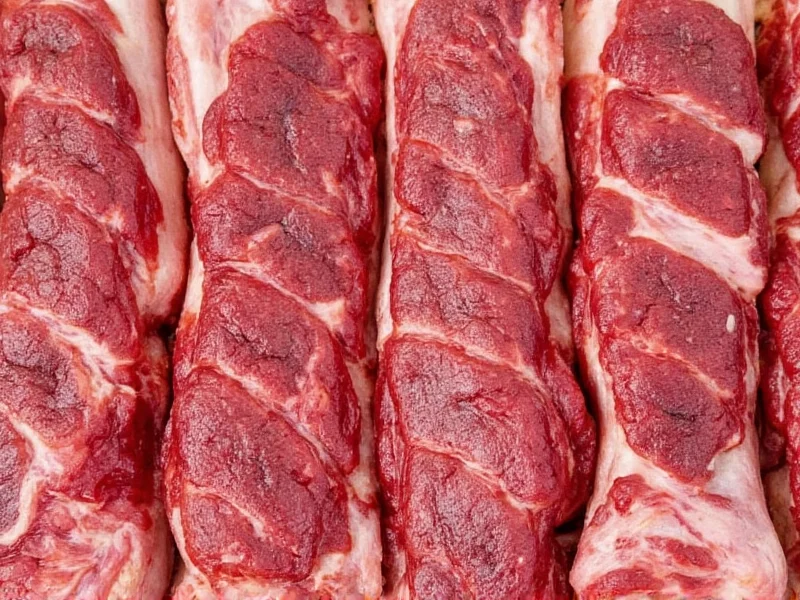When butchers prepare pork ribs, they separate the rib cage into different sections. The upper portion becomes baby back ribs, while the lower, flatter section becomes spare ribs. Rib tips are the triangular-shaped pieces cut from the front end of the spare ribs, where the ribs meet the pig's breastbone. This specific cut contains a higher proportion of cartilage compared to meat, which affects both its cooking properties and flavor profile.
Anatomy of Pork Rib Cuts
Understanding where rib tips originate requires knowledge of pork rib anatomy. The pig's rib cage consists of approximately 15-16 rib pairs. Butchers divide this into three main sections:
| Rib Cut | Location on Pig | Characteristics |
|---|---|---|
| Baby Back Ribs | Upper rib cage, attached to spine | Meatier, curved, less fat, more expensive |
| Spare Ribs | Lower rib cage, belly side | Flatter, more bone, higher fat content |
| Rib Tips | Front end of spare ribs, near sternum | Cartilage-heavy, triangular shape, economical |
Why Rib Tips Are Different From Other Rib Cuts
Rib tips stand apart from other pork rib cuts due to their unique composition. While traditional ribs consist primarily of bone and meat, rib tips contain significant amounts of cartilage and connective tissue. This structural difference affects how they cook and their final texture. When properly prepared, the cartilage in rib tips becomes tender and gelatinous rather than chewy, creating a distinctive eating experience.
The confusion between rib tips and other rib cuts often stems from regional terminology. In many areas outside of Chicago, butchers might simply include rib tips as part of the spare rib section. However, Chicago-style barbecue specifically separates and features rib tips as a distinct menu item, contributing to their association with Midwestern barbecue traditions.
Culinary Applications of Rib Tips
Rib tips have gained particular popularity in Chicago-style barbecue, where they're often slow-cooked until the cartilage becomes tender. Their relatively low cost compared to other rib cuts makes them an economical option for both restaurants and home cooks. The high collagen content transforms during slow cooking, creating a rich, gelatinous texture that many barbecue enthusiasts appreciate.
When preparing rib tips, many pitmasters recommend the "3-2-1" method: three hours of smoking, two hours wrapped in foil with liquid, and one hour of finishing to develop a proper bark. This technique helps break down the cartilage while maintaining moisture. The result is a flavorful, tender product with a unique texture that differs from traditional pork ribs.
Shopping for Quality Rib Tips
When selecting rib tips, look for pieces with a good meat-to-cartilage ratio. While some cartilage is expected, excessive amounts can lead to disappointing results. Fresh rib tips should have a pinkish-red color with white marbling throughout. Avoid pieces with grayish discoloration or excessive liquid in the packaging, which may indicate age or poor handling.
Many grocery stores don't regularly stock rib tips, so you may need to request them from your butcher. When ordering, specify that you want the tips separated from the spare ribs rather than having them included in the spare rib section. This ensures you receive the authentic cut rather than a butcher's approximation.
Common Misconceptions About Rib Tips
One prevalent misconception is that rib tips come from beef rather than pork. Despite the name, rib tips are exclusively a pork product. Another common misunderstanding is that rib tips are simply trimmed pieces of regular ribs. In reality, they represent a specific anatomical section of the pig's rib cage.
Some consumers confuse rib tips with riblets, which are actually small sections cut from baby back ribs. While both contain cartilage, riblets come from a different part of the animal and have a different flavor profile and cooking behavior compared to true rib tips.
Nutritional Profile of Rib Tips
Rib tips contain a different nutritional profile than traditional ribs due to their higher cartilage content. While they still provide protein and essential nutrients like zinc and B vitamins, the cooking process transforms the collagen in cartilage into gelatin, which offers potential joint health benefits. However, like all pork rib cuts, rib tips are relatively high in fat and should be consumed in moderation as part of a balanced diet.
Frequently Asked Questions
Are rib tips actually ribs?
No, rib tips aren't technically ribs. They come from the cartilage section connecting the spare ribs to the pig's breastbone. While they're part of the rib section, they contain more cartilage than bone and meat, making them a distinct cut rather than true ribs.
Why are rib tips particularly popular in Chicago?
Rib tips became popular in Chicago through the city's barbecue tradition, particularly in African American communities. Local pitmasters developed unique preparation methods that transformed this economical cut into a signature dish. The distinctive Chicago-style preparation—slow-cooked with a sweet and tangy sauce—helped establish rib tips as a regional specialty.
How do you cook rib tips properly to avoid chewiness?
To prevent chewiness, cook rib tips using low-and-slow methods for extended periods (typically 3-4 hours). The cartilage needs time to break down into gelatin. Many barbecue experts recommend the "3-2-1" method: 3 hours of smoking, 2 hours wrapped in foil with liquid, and 1 hour of finishing. This ensures the cartilage becomes tender rather than rubbery.
Are rib tips the same as riblets?
No, rib tips and riblets are different cuts. Rib tips come from the front end of pork spare ribs near the breastbone, while riblets are small sections cut from baby back ribs. Riblets contain more meat and less cartilage than rib tips, resulting in different cooking times and textures.
Why are rib tips less expensive than other rib cuts?
Rib tips cost less because they contain more cartilage and less meat than premium cuts like baby back ribs. Historically considered a byproduct of butchering spare ribs, they've gained popularity through regional barbecue traditions. Their lower price point makes them an economical option for both restaurants and home cooks seeking authentic barbecue flavors.











 浙公网安备
33010002000092号
浙公网安备
33010002000092号 浙B2-20120091-4
浙B2-20120091-4